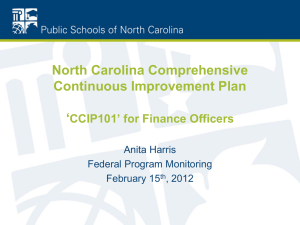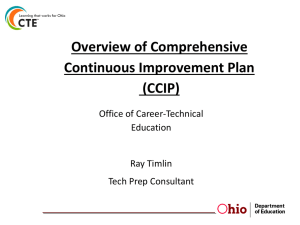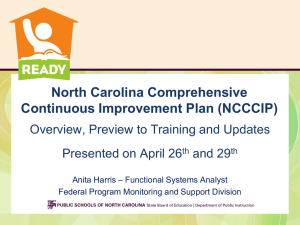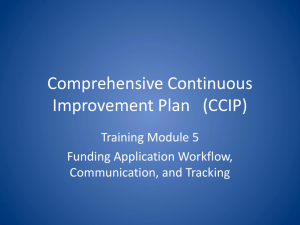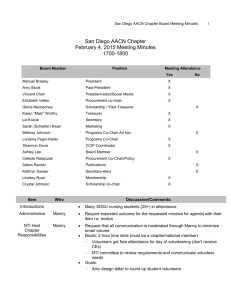Job Analysis Study Summary Report
advertisement
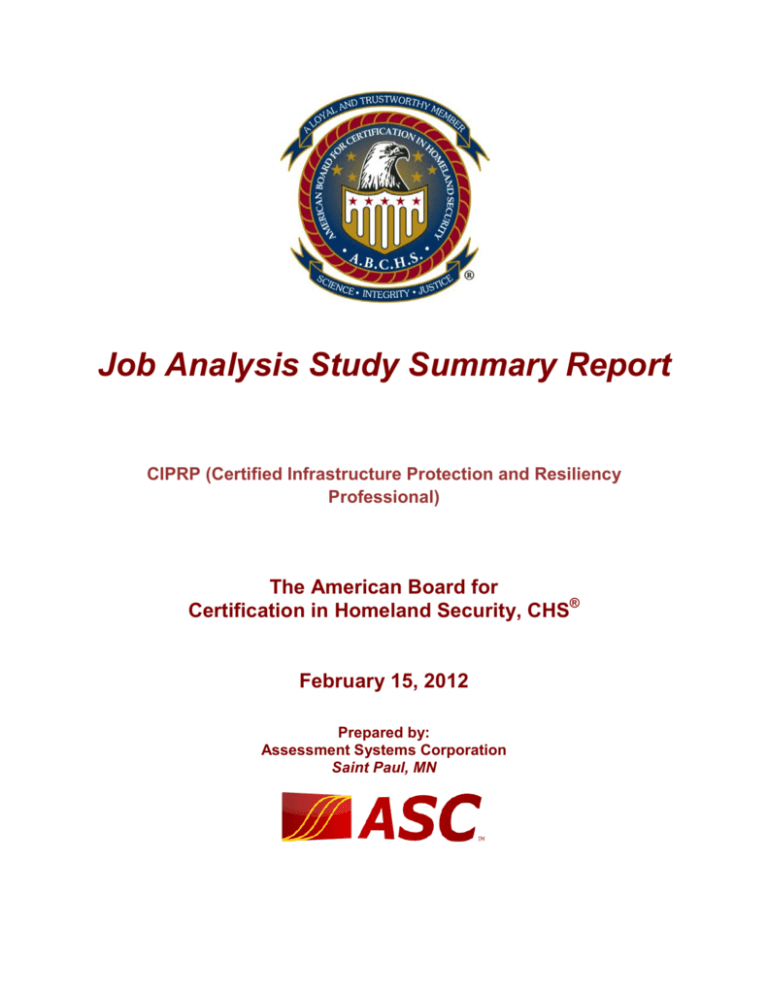
Job Analysis Study Summary Report CIPRP (Certified Infrastructure Protection and Resiliency Professional) The American Board for Certification in Homeland Security, CHS® February 15, 2012 Prepared by: Assessment Systems Corporation Saint Paul, MN INTRODUCTION This report describes the job task analysis (JTA) study for the Certified in Critical Infrastructure Protection, CCIPsm (CCIP) exam sponsored by the American Board for Certification in Infrastructure Protection, (ABCIP). This examination is designed to identify candidates with minimal knowledge and skills to earn the CCIP credential. ABCHS contracted Assessment Systems Corporation, a leading provider of software and services for testing organizations, to provide psychometric consultation in the study. A list of tasks was generated by a panel of experienced infrastructure protection professionals. This list was used to create a survey regarding the importance and frequency of each task; 201 professionals completed the survey, providing empirical information regarding which tasks are most important and are completed most often. This report provides detail on the methodology and results of this survey. METHOD The methodology used in conducting the CCIP job task analysis study is consistent with the validation processes recommended in the American National Standards Institute’s Accreditation Guidelines for Certification Organizations (ANSI Standard 17024), the Accreditation Guidelines of the National Commission for Certification Agencies (NCCA), and the Joint Technical Standards of the American Psychological Association, American Educational Research Association, and the National Council on Measurement in Education. The design and implementation of this study consisted of a number of steps carried out between July and November of 2011. These steps are described below. The ABCHS Executive Committee A committee of subject matter experts (SMEs) is necessary to oversee the job analysis process. ABCIP is is responsible for the development and administration of the Certified in Critical Infrastructure Protection, CCIPsm. The Board led the CCIP job analysis study. The role of the ABCIP Board in this study was to participate in the development of the job analysis survey instrument to ensure that the full range of critical infrastructure-related activities and knowledge areas pertinent to performing these successfully were comprehensively and accurately represented. Specifically, the board formally adopted task and knowledge area lists, reviewed a draft version of the survey instrument, and assisted with the interpretation of the survey data. The committee participated in a variety of conference calls and email discussions regarding the project and the job analysis process. Drafting the Job Analysis Surveys There are several designs available (Brannick & Levine, 2002) for a job analysis study; a model commonly used for credentialing exams is a task inventory (Raymond & Neustel, 2006). The goal of this approach is to produce a comprehensive list of professional tasks performed on the job, then have a wide range of incumbents rate each task on aspects such as importance and frequency or time spent on the task in a normal work week. This provides empirical evidence as to which tasks are more important or more frequent in the job; those tasks should obviously have more weight on the final test than rare or unimportant tasks. Documentation of this process substantially enhances the validity of score interpretations from a certification exam. The following presents an overview of the steps in the study methodology. 1. 2. 3. 4. 5. Develop test definition and broad outline to provide the initial link in the validity chain Generate exhaustive list of task elements and knowledge areas of the profession Review task and knowledge lists Develop rating scales for task and demographic questions to assess sampling Publish and deliver survey with sampling plan The survey development began with a conference call involving members of The American Board for Certification in Infrastructure Protection (ABCIP) on July 14, 2011. In this meeting, Board members began developing a list of critical infrastructure protection job tasks that a minimally competent candidate could perform successfully. Board members collaborated through email over the course of the next month to hone an appropriate list of job task statements. The ABCHS Chief Association Officer oversaw this collaboration. Responses were collected by ABCHS staff and collated with the assistance of subject matter experts. On August 15, ABCIP formally adopted its list of job task statements. The approved list of job tasks contained 123 statements categorized into the following task areas: Incident Management (Planning and Response), Physical Plant Assessment and Consultation, Policy Assessment and Consultation, and Personnel Management. It was agreed that the frequency scale for the tasks would be Regularly, Frequently, Occasionally, and Never. The importance scale would be Extremely, Moderately, Slightly, and Not. The final survey consisted of demographic questions and task statements. On Friday, August 26, 2011, ABCHS staff created the survey instrument in Survey Monkey and forwarded a link to all ABCIP Board members. This link allowed them to preview the survey before distribution. Board members had two weeks to preview the survey and provide Staff with feedback. Administration of the Job Analysis Survey On September 13, 2011, the survey was ready and was emailed to approximately 4,679 specialists with expertise in Critical Infrastructure Protection (including ABCIP Board members). They were given an initial deadline of September 30 to respond. The survey was redistributed in early November to those 4,087 who had not responded. They were given another two weeks, with final responses totaling 201. The respondents appear to be a representative sample of those in the field of Critical Infrastructure Protection. Survey Results The responses to job analysis surveys were collected by SurveyMonkey.com. ABCHS Staff tabulated and analyzed the data. A report on the survey results was prepared for a meeting of the ABCIP Board where the results would be reviewed and test specifications for the CCIP examination would be finalized. Development of the Weighted Content Outline The mean and standard deviation of both time and importance ratings was calculated for each task. In addition, mean time and importance were combined with both an additive model (T + I) and multiplicative model (T × I). Each of these provides an index of the significance of the task in the role of a professional critical infrastructure protection job. Although only one index can be used to make decisions regarding exam content weightings, the use of these calculations provides a logical, empirical link between survey results and test specifications. More important or more frequently performed tasks in the job should obviously have more weight on the final test than rare or unimportant tasks. In the case of the job analysis data for CCIP, both indices were nearly perfectly correlated. The multiplicative method was chosen. ABCIP Board Review and Approval of Test Specifications Board members of the ABCIP began reviewing the Job Analysis and Test Specifications reports on February 17, 2012. They were given until March 7 to review and discuss the results in these reports and to finalize the related proposed test content outline for CCIP. Following discussion of the documents, the ABCIP Board finalized the CCIP Job Analysis Report, Test Specifications Report, and exam content outline as it was proposed and without revision. The board finalized this discussion on March 5, 2012. SUMMARY This report describes a job analysis study for the Certified in Critical Infrastructure Protection, CCIPsm certification program. The goal of the study was to produce a comprehensive list of professional tasks performed on the job, with empirical data regarding the importance and frequency of those tasks to garner detailed data on the current structure of the jobs performed by professionals in this role and to better understand the field of critical infrastructure protection. A job analysis study is an essential foundation for the validity of a certification program. The first step was the development of the list of tasks and knowledge areas by a committee of highly experienced subject matter experts. Once this was completed, a survey was constructed utilizing the list as well as a number of demographic variables. The data set was analyzed to provide a depiction of both the demographic qualities of the sample as well as the structure of the profession and a proposed test content outline. While the foundation of validity, the completion of a job analysis survey is only one step in the test development cycle. The next step is to develop a test that strictly adheres to the finalized content outline. Each item must be specifically mapped to a content area, and the percentage of items from each content area must match the finalized percentages.
